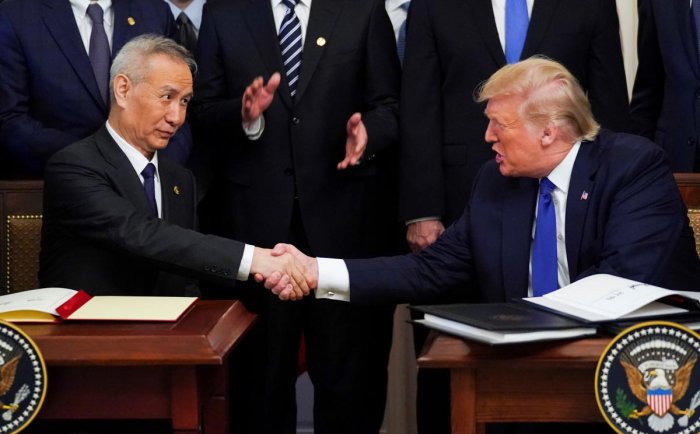China has agreed to buy hundreds of billions of dollars worth of products from the United States as part of their “phase one” trade deal.The agreement signed Wednesday will have Beijing ramp up its purchases of US goods and services by $200 billion compared to its orders in 2017, before the trade war started. China imported over $185 billion in total US goods and services that year. In exchange, Washington has agreed to reduce tariffs on $120 billion in Chinese products from 15% to 7.5%.
Under the agreement, the extra Chinese purchases will be made over the next two years, with agricultural products accounting for a large chunk. China has said it will buy an additional $12.5 billion of those goods in year one, compared to 2017, and then $19.5 billion in year two.
Among the products it has promised to buy are soybeans, pork, cotton and wheat. Trade in soybeans and pork in particular has been hit hard as tensions have escalated between the world’s two largest economies. Both products were among thousands of US goods hit by Chinese tariffs in July 2018, in response to the Trump administration’s taxes on $34 billion of Chinese goods.In addition to the purchases announced on Wednesday, the initial deal provides better protection to American companies that have long complained about thefts of their intellectual property and trade secrets.It also loosens up requirements for banks wanting to operate in China and imposes anti-counterfeiting measures that, if broken, would lead to penalties.
Beijing’s pledges go further than China has in the past, but the agreement doesn’t require the government to change any laws or regulations. And China still didn’t give ground on some of the most important issues for America, such as demands for cuts to state subsidies that could trigger a fundamental overhaul of how the Chinese economy works. That is among several sticking points that the two sides are expected to discuss for the next phase of the agreement.
For now, the deal is expected to bring some relief to Chinese manufacturers, who have suffered from tariffs that made their goods more expensive. It also lifts some of the uncertainty that had been clouding companies’ decisions to invest in China.Additionally, the agreement fits neatly into one of Beijing’s key goals: to diversify its economy and reform its financial system. China’s central bank said in a statement Thursday that the deal would help it continue to open up the country’s financial sector.Going forward, a senior US administration official told reporters that Washington would be “actively monitoring” data sources from both countries to ensure that China is fulfilling its promise.












![Hotstar Premium Cookies 2019 [*100% Working & Daily Updated*] Hotstar Premium Cookies 2019 [*100% Working & Daily Updated*]](https://tahav.com/wp-content/uploads/2019/11/Hotstar-Premium-Cookies-Free-100x70.jpg)



